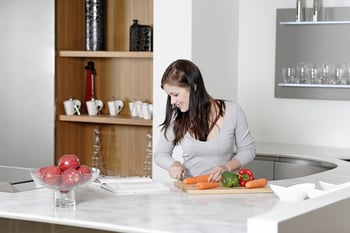
One of the struggles of discovering that you have a gluten intolerance is then trying to figure out what you can eat and especially how to put your meals together. You no longer eat rice or pasta as a side, bread your chicken, have dinner rolls, or eat anything you want. Even if you were on a low-carb or low-calorie diet previously, the gluten-free diet is not going to allow for the same types of foods. Here are some helpful ways to put together your gluten-free meals.
Get a Gluten-Free Cookbook
 To start with, it is really helpful to have at least one gluten-free cookbook, but preferably a few different ones. These are going to be your point of reference not just for making sure you have plenty of recipes to choose from - but so you know what foods you can and can’t have. Many of the gluten-free cookbooks available are going to provide food lists, tips, and suggestions for creating meals that help with your gluten intolerance. While many of them cater to allergies or Celiac disease, you can still use the same recipes for your gluten sensitivity.
To start with, it is really helpful to have at least one gluten-free cookbook, but preferably a few different ones. These are going to be your point of reference not just for making sure you have plenty of recipes to choose from - but so you know what foods you can and can’t have. Many of the gluten-free cookbooks available are going to provide food lists, tips, and suggestions for creating meals that help with your gluten intolerance. While many of them cater to allergies or Celiac disease, you can still use the same recipes for your gluten sensitivity.
Start Baking Your Own Bread
This might sound like a huge chore, but once you make your own loaf of bread, you will wonder why you haven’t always done it. There is something about getting bread out of the oven or using a bread maker that is satisfying. Pulling a loaf of bread you made from scratch and slicing it up yourself is rather cathartic, not to mention the smell and fresh taste when it comes from your own kitchen. Baking your own bread helps to save money since you can use a gluten-free bread recipe instead of having to buy an expensive alternative at a local health foods store. Bread machines are easy to use and a quick way to make your own bread.
Find Grain Alternatives
While you can’t have many of the grains you are used to, there are still some that don’t contain gluten. Finding these and using them in your meals can really make up for what you are missing. For example, you might not be able to have some forms of rice or pasta, but you can still have quinoa. This is always gluten-free, healthy, low-fat, and really easy to include in all of your recipes. Also look for foods that naturally don’t have gluten so you don’t have to second guess anything, such as fresh produce, beans, nuts, and seeds.
Get Rid of the Processed Stuff
With things like dairy and meat, it is okay to eat these food items, but you want to avoid anything that is processed. Now is the perfect time to stop eating so much processed food and rely more on the natural options. Instead of hot dogs/deli meat, opt for ground turkey or chicken breasts.

